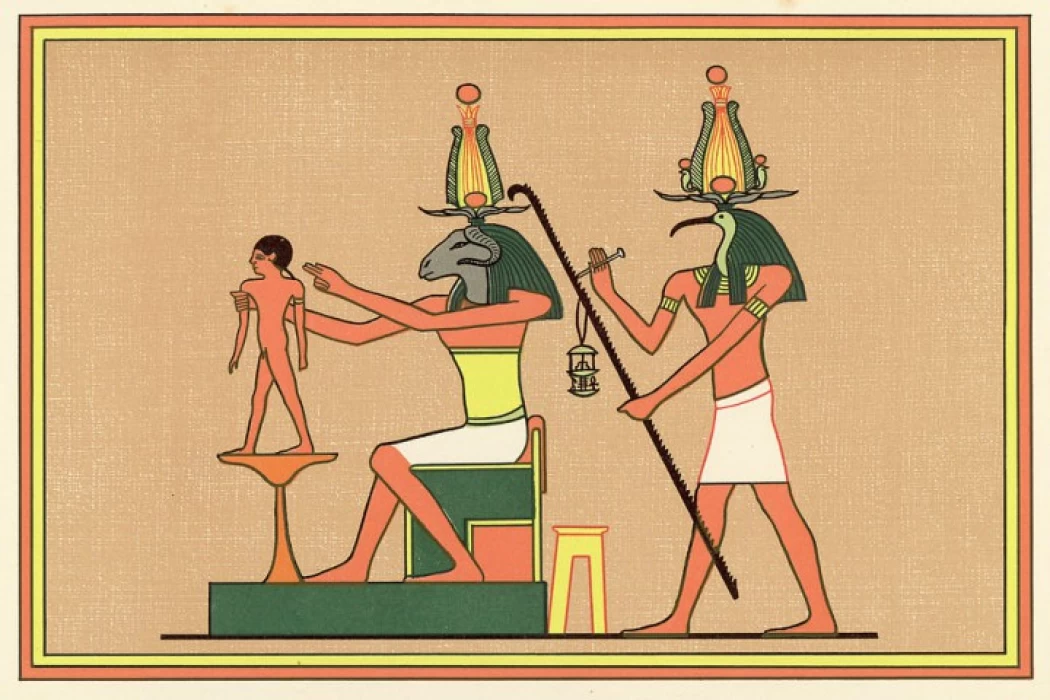
The God Khnum
According to ancient Egyptian belief, Khnum performed the process of the physical creation of man from the silt of the Nile on a pottery wheel. Some accounts say that he formed small children from the Nile silt available at Aswan and put them in the wombs of their mothers. He was worshipped in various places in Egypt, such as Aswan, Esna, and Memphis (Menf) as the God who brought the Nile to establish life on its banks.
It dates back to the Old Kingdom era, where he was known in the religion of the ancient Egyptians as "NEB-qabhu", that is, the Lord of water, and was also worshiped during the New Kingdom era, and Elephantine was the center of his worship.
During the Middle Kingdom era, Khnum was revered as the one who brought the Nile flood and its silt and fertility to the land, and these inscriptions were painted on the new Satis temple, where the text did not mention Khnum's tasks in the past. With the advent of the Nineteenth Dynasty of Egypt during the New Kingdom, Khnum assumed the title of NEB-Abu, that is, the Lord of two elephants. And before that, it was the goddess Satis who bore the title of "Lady of Elephantine."
Importance and centers of worship
In the ancient kingdom, in particular, Khnum was considered the patron god of Elephantine Island and the area around the Aswan falls, and for this, he also had the title of "Lord of the falls" (NEB-qabhu). Thus, during the new state, together with his wife Satis and their daughter anokis, he formed the so-called "elephantine trilogy. But in ISNA the trio of Khnum, "minhet" and their son was considered "truly". His cult during the eighth dynasty (the first transitional era) was mixed with the cult of RA and the Egyptians called him "Khnum-Ra" and the first oldest inscriptions were found in the temple of dibod.
Among the most important areas of his worship were the island of Elephantine, elephants, Esna, and "hut-ur" in the south and the north in "Tarkhan"
God Khnum
This deity was known as the god of the waters that circulated in the lower world, in this way, when the sun was shipwrecked in the darkness of the night, Khnum unconsciously joined it.
The ram god, whose name is derived from the verb "khnem" meaning "to create," indicating that he was a creator from the beginning. Perhaps because of his creative ability, and because the phonetic connotation of the ram (bA) matches the word "ba" (meaning: spirit), he was referred to by the title (bA Ra).
Among the most outstanding functions of this god in Egyptian religion, is that of creating living beings, men, and gods thanks to his potter's wheel, a place from which many claimed that the primordial egg had been born.
It is worth mentioning that with the pottery function, with which he created people at the same time as his Ka, he was given the name "The father of fathers and mother of mothers" in such a way that Khnum means literally "the modeler".
In the same way, the oldest legends tell, that at the beginning of time, Khnum was dedicated to creating each man and each woman separately, but one day, Khnum woke up tired of doing this task, so without thinking he broke his lathe potter, thus introducing a different part of it in each woman, so each of them was given the role of giving birth to the next generations.
His Association with Other Deities. He was associated with the goddesses Menhet and Neith at the temple of Esna.
Khnum, along with the goddesses Satet and Anqet, formed the First Cataract triad at Elephantine. He was also united at Elephantine with the gods Shu and Horus. On the other hand, the Greeks equated him with the god Amun at Thebes, perhaps because both were associated with the ram.
Elephantine Island and the region surrounding the Aswan Falls were thought to be protected by Khnum. "Lord of the Falls" was another name for him in the Old Kingdom. During the New Kingdom, he and his wife, Satis, and their daughter, Anukis, formed what is known as the "Elephantine Triad." He was worshipped in many areas of Upper Egypt and Nubia, but his worship declined in northern Egypt and the Delta. Among his most important worship sites were Elephantine Island, Philae, Esna, Edfu, Asyut, Kom Ombo, and Mendes. Since the First Dynasty, the belief in sacred rams has been known.
Esna Temple
His temple at Esna is his best-preserved temple, and its texts provide us with a wealth of information about this deity and his worship.
The Greco-Roman Temple of Khnum in Esna was built during the reign of the Roman Emperor Claudius and dedicated to the worship of the ram-headed creator god. All that remains of the temple is the hall, whose ceiling rests on columns. The ceiling, supported by 24 columns, is decorated with images depicting rural scenes and hymns to the god Khnum. This temple was discovered in the 1840s. You can see the carved plant motifs and images of Roman celestial beings, along with hieroglyphic inscriptions representing the rituals performed at the temple.














